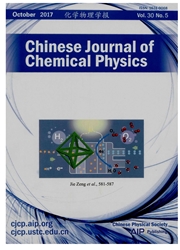

 中文摘要:
中文摘要:
采用共振拉曼光谱学和完全活化空间自洽场方法研究了苯基叠氮被激发到S2(A,)、S3(A’)和S6fA’)光吸收态后的结构动力学.基于傅立叶变换拉曼、傅立叶变换红外、紫外、密度泛函计算和简正模式分析,指认了紫外吸收光谱和振动光谱.获得了环己烷、乙腈和甲醇溶剂中273.9、252.7、245.9、228.7、223.1和208.8nm等不同激发波长下的A、B和C带共振拉曼光谱,以探测Franck—Condon区域的结构动力学.CASSCF计算获得了单重电子激发态能量最低点和势能面交叉点的电子激发能和优化几何结构.结果表明,苯基叠氮在S2(A,)、S3(A’)和S6(A’)态上的激发态结构动力学各不相同.与Kasha规则相符,S2S1(1)和S2Sa(2)势能面交叉点在S2(A’)激发态衰变动力学和N7=N8键解离中扮演着重要角色.提出了两条主要衰减通道:S2,min→S0S2,FC(ππ^*)→S2(ππ)/S1(ππ^*)→S1(nπ^*)非辐射通道.
 英文摘要:
英文摘要:
The excited state structural dynamics of phenyl absorbing S2(A'), S3(A'), and S6(A') states were troseopy and complete active space self-consistent and the UV absorption bands were assigned on azide (PhN3) after excitation to the light studied using the resonance Raman specfield calculations. The vibrational spectra the basis of the Fourier transform (FT)- Raman, FT-infrared measurements, the density-functional theory computations and the normal mode analysis. The A-, B-, and C-bands resonance Raman spectra in cyclohex- ane, acetonitrile, and methanol solvents were, respectively, obtained at 273.9, 252.7, 245.9, 228.7, 223.1, and 208.8 nm excitation wavelengths to probe the corresponding structural dynamics of PhN3. The results indicated that the structural dynamics in the S2 (A'), S3(A'), and S6(A') states were significantly different. The crossing points of the potential energy surfaces, S2S1(1) and S2S1(2), were predicted to play a key role in the low-lying excited state decay dynamics, in accordance with Kasha's rule, and NT=N8 dissociation. Two decay channels initiated from the Franck-Condon region of the S2(A') state were predicted: the radiative S2,min→S0 radiative decay and the S2→S1 internal conversion through the crossing points S2S1 (1)/S2S1(2).
 同期刊论文项目
同期刊论文项目
 同项目期刊论文
同项目期刊论文
 Phosphorescent mechanism for single-dopant white OLED of FPt: electronic structure and electron exch
Phosphorescent mechanism for single-dopant white OLED of FPt: electronic structure and electron exch Vibronic coupling and excited-state reaction dynamics of pyrazine in 1 1B2u (1pp*) state by resonanc
Vibronic coupling and excited-state reaction dynamics of pyrazine in 1 1B2u (1pp*) state by resonanc Effects of Antimicrobial Peptide Revealed by Simulations: Translocation, Pore Formation, Membrane Co
Effects of Antimicrobial Peptide Revealed by Simulations: Translocation, Pore Formation, Membrane Co Probing Highly Efficient Photoisomerization of a Bridged Azobenzene by a Combination of CASPT2//CASS
Probing Highly Efficient Photoisomerization of a Bridged Azobenzene by a Combination of CASPT2//CASS Understanding Bacterial Bioluminescence: A Theoretical Study of the Entire Process, from Reduced Fla
Understanding Bacterial Bioluminescence: A Theoretical Study of the Entire Process, from Reduced Fla Theoretical insight towards the photo-dissociation dynamics of O-3-H2O complex: Deep understanding t
Theoretical insight towards the photo-dissociation dynamics of O-3-H2O complex: Deep understanding t Photo-induced isomerization of ethylene-bridged azobenzene explored by ab initio based non-adiabatic
Photo-induced isomerization of ethylene-bridged azobenzene explored by ab initio based non-adiabatic Excited State Structures and Decay Dynamics of 1,3-Dimethyluracils in Solutions: Resonance Raman and
Excited State Structures and Decay Dynamics of 1,3-Dimethyluracils in Solutions: Resonance Raman and ON-OFF Mechanism of a Fluorescent Sensor for the Detection of Zn(II), Cd(II), and Cu(II)Transition M
ON-OFF Mechanism of a Fluorescent Sensor for the Detection of Zn(II), Cd(II), and Cu(II)Transition M The combined CASPT2 and CASSCF studies on photolysis of 3-thienyldiazomethane and subsequent reactio
The combined CASPT2 and CASSCF studies on photolysis of 3-thienyldiazomethane and subsequent reactio Concerted Asynchronous Hula-Twist Photoisomerization in the S65T/H148D Mutant of Green Fluorescent P
Concerted Asynchronous Hula-Twist Photoisomerization in the S65T/H148D Mutant of Green Fluorescent P Structural dynamics of phenylisothiocyanate in the light-absorbing excited states: Resonance Raman a
Structural dynamics of phenylisothiocyanate in the light-absorbing excited states: Resonance Raman a Photoinduced Proton Transfer and Isomerization in a Hydrogen-Bonded Aromatic Azo Compound: A CASPT2/
Photoinduced Proton Transfer and Isomerization in a Hydrogen-Bonded Aromatic Azo Compound: A CASPT2/ Mechanism of Water Oxidation to Molecular Oxygen with Osmocene as Photocatalyst: A Theoretical Study
Mechanism of Water Oxidation to Molecular Oxygen with Osmocene as Photocatalyst: A Theoretical Study State-specific heavy-atom effect on intersystem crossing processes in 2-thiothymine: A potential pho
State-specific heavy-atom effect on intersystem crossing processes in 2-thiothymine: A potential pho Decay dynamics of alpha,beta-carboxylic methyl esters (CH3OCOCH:CHR) in the lower-lying excited stat
Decay dynamics of alpha,beta-carboxylic methyl esters (CH3OCOCH:CHR) in the lower-lying excited stat Vibronic-Coupling and Excited State Reaction Dynamics of Pyrazine in 1B2u State by Resonance Raman S
Vibronic-Coupling and Excited State Reaction Dynamics of Pyrazine in 1B2u State by Resonance Raman S Mechanism investigation of ketone hydrogenation catalyzed by ruthenium bifunctional catalysts: insig
Mechanism investigation of ketone hydrogenation catalyzed by ruthenium bifunctional catalysts: insig Exploring Concerted Effects of Base Pairing and Stacking on the Excited-State Nature of DNA Oligonuc
Exploring Concerted Effects of Base Pairing and Stacking on the Excited-State Nature of DNA Oligonuc Synchronous concerted multiple-body photodissociation of oxalyl chloride explored by ab initio-based
Synchronous concerted multiple-body photodissociation of oxalyl chloride explored by ab initio-based Azomethine ylide-formation from N-phthaloylglycine by photoinduced decarboxylation: A theoretical st
Azomethine ylide-formation from N-phthaloylglycine by photoinduced decarboxylation: A theoretical st Direct Observation of 4-Phenoxyphenylnitrenium Ion: A Transient Absorption and Transient Resonance R
Direct Observation of 4-Phenoxyphenylnitrenium Ion: A Transient Absorption and Transient Resonance R Direct Time-Resolved Spectroscopic Observation of Arylnitrenium Ion Reactions with Guanine-Containin
Direct Time-Resolved Spectroscopic Observation of Arylnitrenium Ion Reactions with Guanine-Containin Decay dynamics of α,β-carboxylic methyl esters (CH3OCOCH:CHR) in the lower-lying excited states-Reso
Decay dynamics of α,β-carboxylic methyl esters (CH3OCOCH:CHR) in the lower-lying excited states-Reso Vibrational spectroscopic study of polymorphism and polymorphic transformation of the anti-viral dru
Vibrational spectroscopic study of polymorphism and polymorphic transformation of the anti-viral dru Time-resolved spectroscopic and density functional theory investigation of the photochemistry of sup
Time-resolved spectroscopic and density functional theory investigation of the photochemistry of sup 期刊信息
期刊信息
